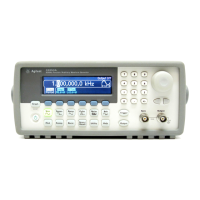298
Chapter 7 Tutorial
Creating Arbitrary Waveforms
7
Creating Arbitrary Waveforms
For most applications, it is not necessary to create an arbitrary waveform
with a specific number of points since the function generator will repeat
points (or interpolate) as necessary to fill waveform memory. For example
,
if you specify 100 points, each waveform point will be repeated an
average of 16,384 / 100 or 163.84 times. For the 33250A, you do not have
to change the length of the waveform to change its output frequency.
All you have to do is create a waveform of any length and then adjust the
function generator’s output frequency. However,
in order to get the best
results (and minimize voltage quantization errors
), it is recommended
that you use the full range of the waveform DAC (use all 4,096 levels).
When entering waveform points from the function generator’s front panel
,
you are not required to enter the points at evenly-spaced intervals in time
.
You can always add additional points as needed where the waveform is
more complex. From the front panel only, you can also use linear
interpolation to smooth the transition between waveform points.
These features make it possible to create useful arbitrary waveforms
using a relatively small number of points.
With the 33250A, you can output an arbitrary waveform to an upper
frequency limit of 25 MHz. However, note that the useful upper limit is
usually less due to the function generator’s bandwidth limitation and
aliasing. Waveform components above the function generator’s -3 dB
bandwidth will be attenuated.
For example, consider an arbitrary waveform consisting of 10 cycles of a
sine waveform. When you set the output frequency to 5 MHz, the actual
output frequency will be 50 MHz and the amplitude will be attenuated
by 3 dB. As you increase the frequency above 5 MHz, more attenuation
will occur. At approximately 8 MHz, waveform distortion due to aliasing
will become evident. Some aliasing will be present in most arbitrary
waveforms, but whether or not it will be troublesome depends on your
specific application.
When creating arbitrary waveforms, the function generator will always
attempt to replicate the finite-length time record to produce a periodic
version of the data in waveform memory. However, as shown on the
following page, it is possible that the shape and phase of a signal may be
such that a discontinuity is introduced at the end point. When the
waveshape is repeated for all time, this end-point discontinuity will
introduce leakage errors in the frequency domain because many spectral
terms are required to describe the discontinuity.

